- Academics
-
Research
- Observatories
- Extragalactic Studies at UVA
- Planetary Science
- Virginia Institute of Theoretical Astronomy
- X-ray Astronomy and Clusters of Galaxies Group
- Near-Field Cosmology
- Exploding Stars and Time Domain Astronomy
- Galaxy Evolution and Cosmology Initiative (GECO)
- Virginia Initiatives on Cosmic Origins
- Outreach
- People
X-ray Astronomy and Clusters of Galaxies Group
Overview
The X-ray Astronomy and Clusters of Galaxies Group does both observational and theoretical work related to X-ray astronomy and the physics of clusters of galaxies, galaxies, X-ray binaries, and compact objects.
Personnel
Faculty, scientists and staff involved in our group include:
- Professor Craig Sarazin
- NRAO Scientist Brian Mason
- Visiting Professors Greg Sivakoff, Ming Sun
- Visiting Scientist Rukmani Vijayaraghavan
Undergraduate students working in this group include:
- Ben Cohen
- Vibha Velmurugan
Recent Research Projects and Papers
https://uva.theopenscholar.com/craig-sarazin/about
Note that most of these projects involve collaborations with at many other scientists and institutions around the world.
Clusters of Galaxies
X-ray Observations of Clusters of Galaxies
| Mergers, Shocks, and Radio Relics |
Merger Shock in Abell 3667 |
| Cluster radio relics are diffuse radio sources in clusters of galaxies not associated with any active galaxy. Radio relics and cluster radio halos are only found in clusters undergoing mergers. Using X-ray observations, we have found that several clusters with radio relics have merger shocks at the outer edge of the relic. We argue that the relativistic electrons in the relics are (re)accelerated by the merger shocks. Recent papers on clusters with radio relics and merger shocks include Abell 3667 (at right), Abell 1367, HSC J023336-053022, and the NGC 6338 group. | 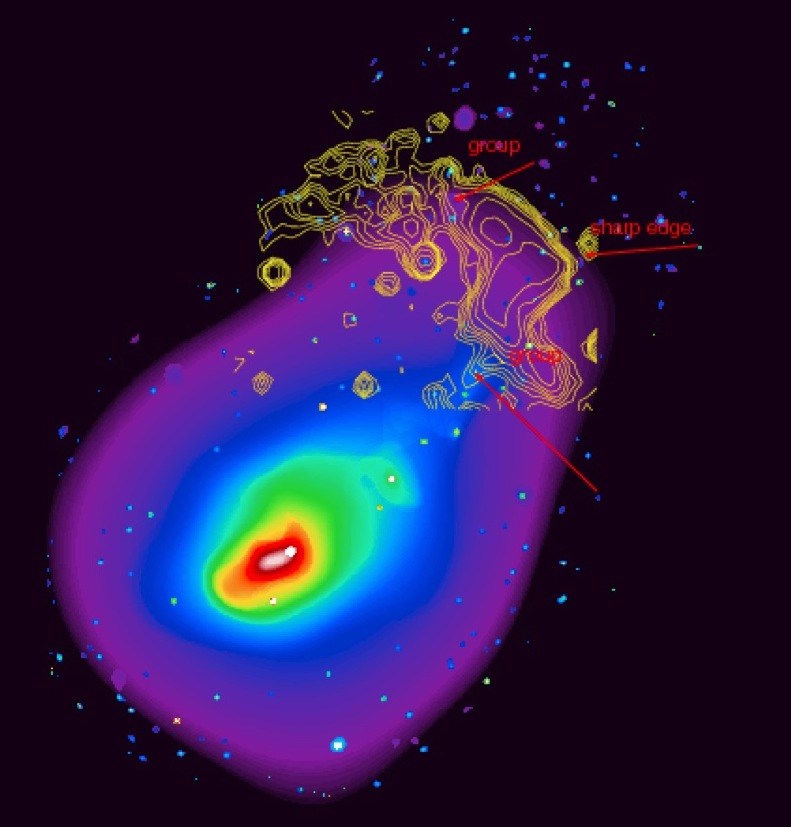 |
| Cluster Cool Cores and Feedback | 3C88 (Radio Contours and Chandra X-ray) |
| Clusters that have not undergoine recent major mergers generally have cool cores at the centers. These are coincident with Brightness Cluster Galaxies (BCGs), which are generally radio AGNs. These cool core galaxies often have cool gas and star formation. The radiative cooling times in the cool cores are short (<109 years). Jets from the central radio source appear to offset most of the cooling, a process called "radio mode feedback." Recent papers on cool core clusters include 3C88 (at right), 3C220.1, and Hydra A. | 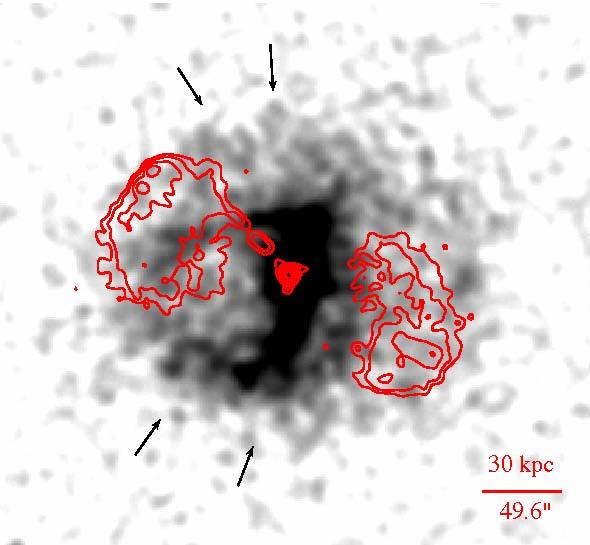 |
Ram Pressure Stripping
| Numerical Simulations | MHD Simulation of Stripping of Spiral Galaxies |
| Galaxies in cluster are predominantly elliptical and SO galaxies, and generally lack much cool gas or star formation. When a gas-rich galaxy falls into a cluster, it's interstellar gas can be stripped by ram pressure as it passes through the intracluster medium. Thermal conduction from the hot ICM can also evaporate the gas. Rukmani Vijayaraghavan and I have made high resolution numerical MHD simulations of gas stripping including the effects of magnetic fields and anisotropic thermal conduction, for spiral galaxies (at right) and elliptical galaxies (Paper I, Paper II). | 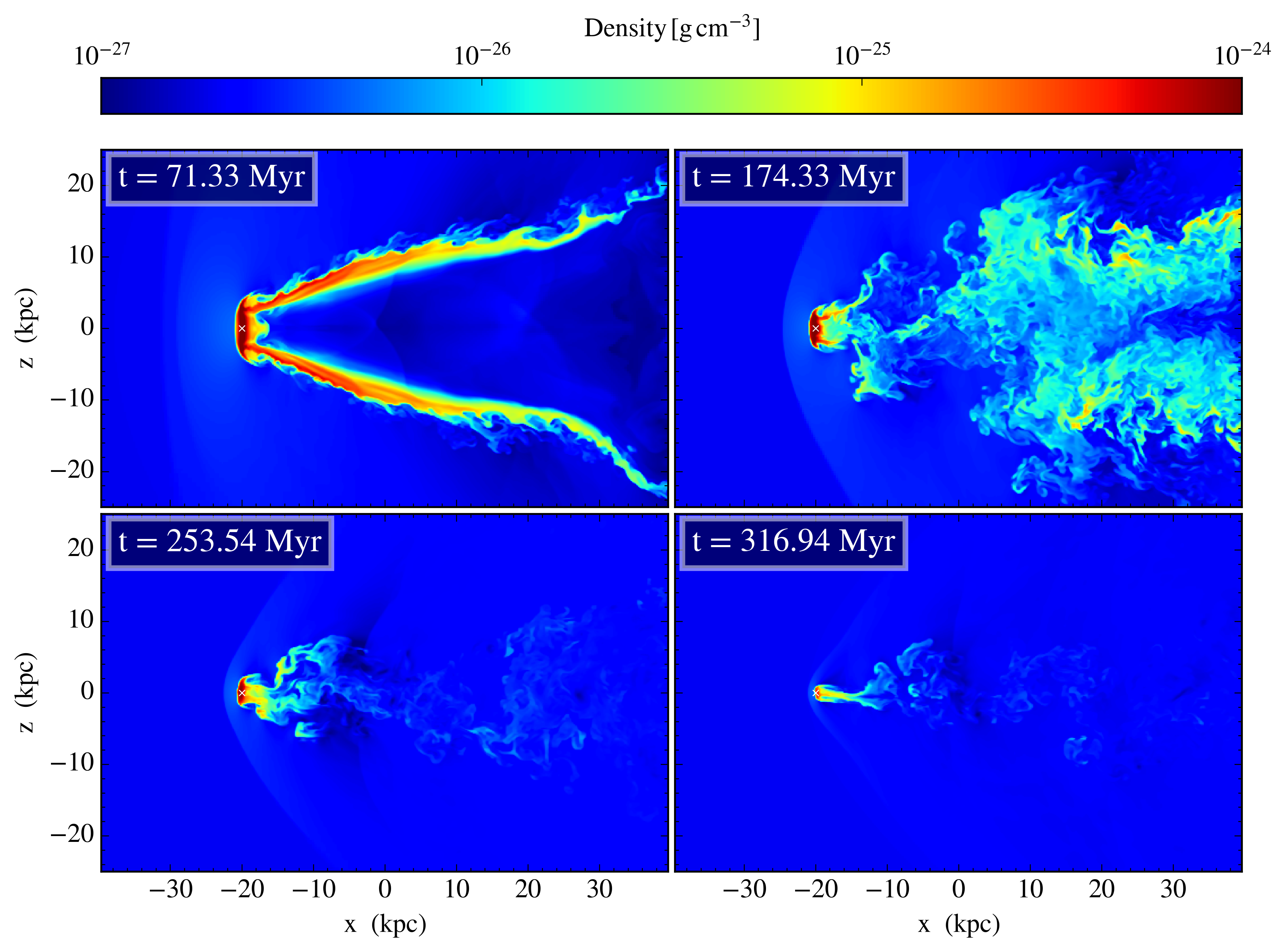 |
| X-ray, Optical, & Radio Observations |
ESO 137-001 |
| Spirals galaxies that are undergoing ram pressure stripping of their interstellar gas often show extended tails in X-rays, optical emission lines, star formation, H I, and X-ray binaries. Examples include ESO 137-001 (at right) and ESO 137-002 in the Abell 3627. Both spirals and early-type galaxies in clusters often have radio synchrotron tails as well. We have a recent detailed study of the tails in the Coma cluster. | 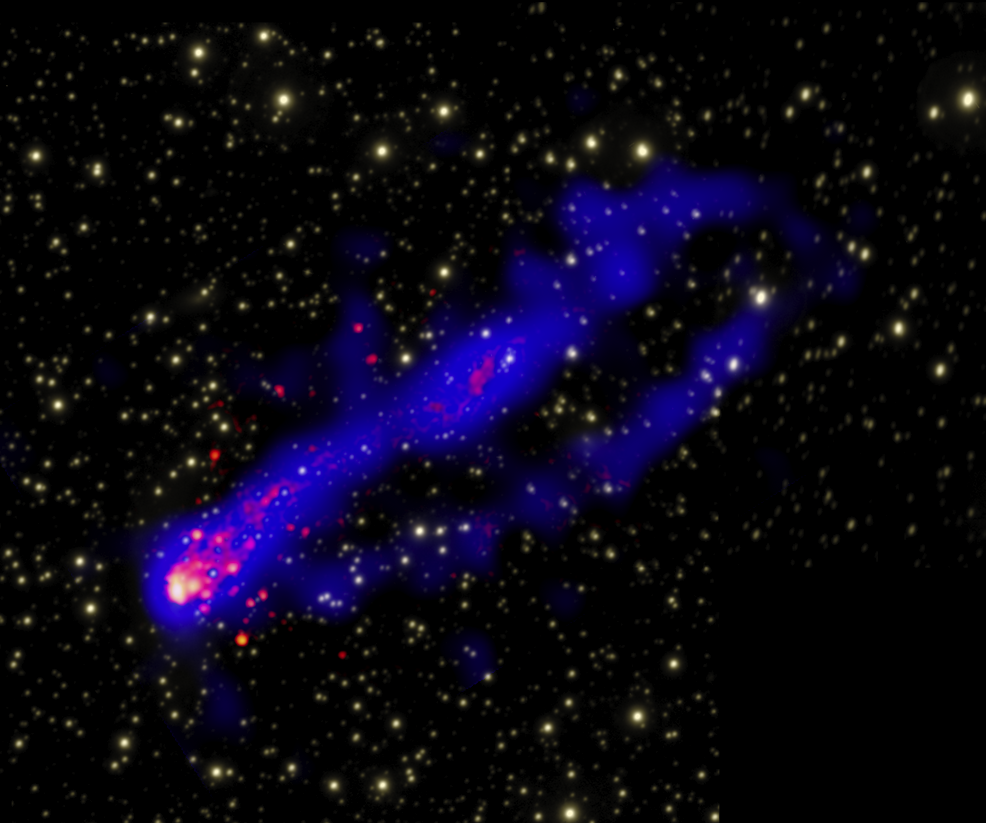 |
High Resolution SZ Observations of Clusters of Galaxies with MUSTANG-2
| MUSTANG-2 SZ Observations |
HSC J023336-053022 |
| The electrons in the hot gas in clusters of galaxies scatter photons from the Cosmic Microwave Background (CMB), in the process transfering energy to the CMB photons. At low frequencies, this Sunyaev-Zeldovich effect reduces the surface brightness of the CMB towards clusters. The MUSTANG-2 camera on the Green Bank Telescope is providing some of the highest resolution images (9") of the SZ effect in clusters. Recent papers include a combined X-ray and SZ study of three XXL clusters (at right), and SZ observations of MaDCoWS clusters, and Zwicky 3146. | 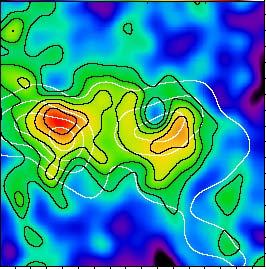 |
Numerical Simulations
| Cluster Mergers | SLAM Simulation of Merger (Temperature) |
| Cluster of galaxies form hierarchically, from the merger of individual galaxies, groups of galaxies, and clusters of galaxies. Major cluster mergers are the most energetic events that have occurred since the Big Bang. The Simulation Library of Astrophysical galaxy cluster Mergers (SLAM, at right) is an extensive set of binary cluster mergers. A movie of the temperature in one example SLAM simulation is given here. There is a paper with Paul Ricker giving earlier simulations. | 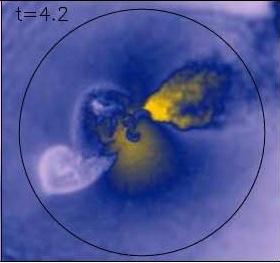 |
| Ram Pressure Stripping | 3D Image of Ram Pressure Stripping |
| Galaxies in cluster are predominantly elliptical and SO galaxies, and generally lack much cool gas or star formation. When a gas-rich galaxy falls into a cluster, it's interstellar gas can be stripped by ram pressure as it passes through the intracluster medium. Thermal conduction from the hot ICM can also evaporate the gas. Rukmani Vijayaraghavan and I have made high resolution numerical MHD simulations of gas stripping including the effects of magnetic fields and anisotropic thermal conduction, for spiral galaxies (at right) and elliptical galaxies (Paper I, Paper II). A movie is shown here. | 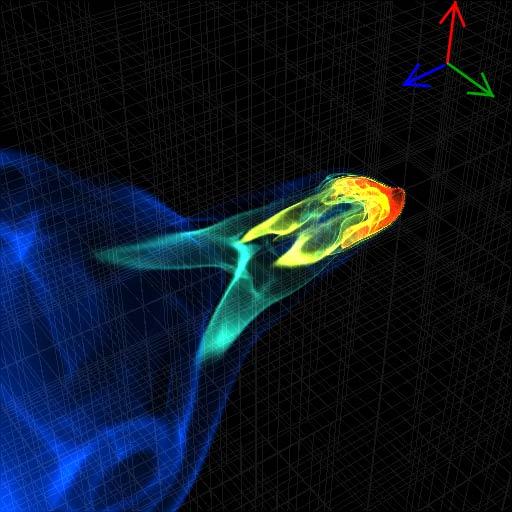 |
Thermal Winds from Quasars
| SZ and X-ray Observations of Thermal Winds from Quasars |
HE 0515-4414 Thermal Wind |
| Thermal winds from quasars and other AGNs could be a major sources of energetic feedback to their host galaxies and environment. They are difficult to see in X-rays because of the proximity to the AGN. Thermal wind bubbles can produce a significant Sunyaev-Zeldovich signal that is detectable in radio-quiet quasars. We made the first detection of such a bubble, associated with the hyperluminous quasar HE 0515-4414 with ALMA (at right). One very interesting feature of the SZ effect in quasar winds is that the thermal and kinetic effect are similar. For a symmetric outflow, the two can nearly cancel at lower frequencies for the side of the outflow towards us, and reverse at higher frequencies. | 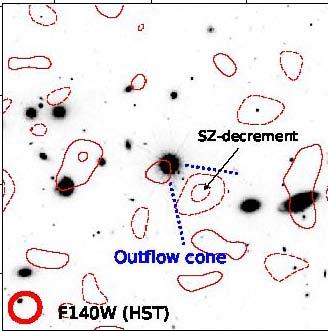 |
X-Ray Binaries
| Jet Acceleration in Galactic Black Hole Binaries | Lenses-Thirring Precession in V404 Cygni |
| X-ray binary systems in the Milky Way provide detailed information on the physics of accretiion by compact objects (white dwarfs, neutron stars, and black holes). One important area we have studied is the physics of jet acceleration by accration by compact objects. Perhaps the most important result is the detections of Lense-Thirring precession by the accretion disk and thus jets in V404 Cygni (at right, also a wonderful movie). Other recent papers on Galactic X-ray binaries include a studies of the jet spectral of the jet spectral breaks in MAXI J1535-5711, a radio parallax for MAXIJ1820+070, and an orbit and period for the supersoft X-ray binary Draco C1. | 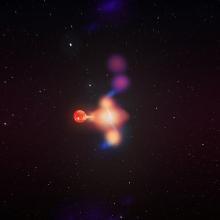 |
Populations of X-ray Binaries
| X-ray Binary Populations in Elliptical Galaxies | Centaurus A (Chandra X-rays) |
| Chandra X-ray observations of early-type galaxies have shown that the X-ray binaries are low mass X-ray binaries, and that a high fraction are locate in globular clusters. An example is Centaurus A (at right), which also as a radio AGN with jets, a merging spiral galaxy, radio lobes with both thermal and nonthermal shocks, and hot interstellar gas. | 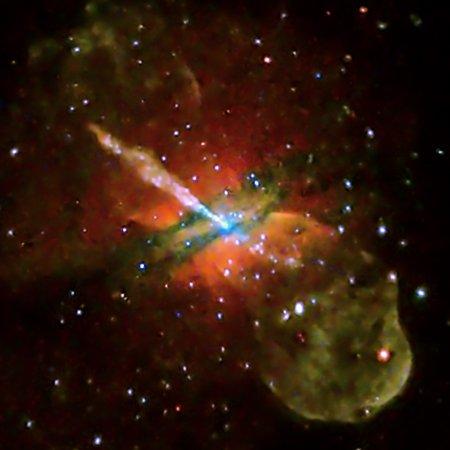 |